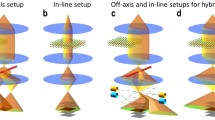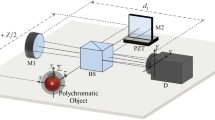Abstract
Deflection is recorded at different sensilivities over a limited portion of the holographic range by introducing equal but opposite phase changes into the holograms created by a dual-beam illumination. The technique does not require a partially reflecting mirror, patterns can be optically filtered for better fringe contrast and in-plane displacement can be recorded without making any modifications in the experimental setup. Results obtained from two-and three-dimensional surfaces agree well with theory and verify analytical arguments presented throughout the paper.
Similar content being viewed by others
Abbreviations
- d:
-
displacement vector
- d 1 :
-
inner diameter of pipe
- d o :
-
outer diameter of pipe
- ê1 :
-
unit vector in direction of propagation
- n i :
-
fringe order number
- r, θ, Z :
-
polar coordinates
- C :
-
center of rotation
- D :
-
distance between model and photographic plate
- E :
-
elastic modulus
- L :
-
length of pipe
- M 1 :
-
applied torque
- P :
-
object point
- R :
-
radius of disk
- U, V, W :
-
scalar components of displacement
- X, Y, Z :
-
cartesian coordinates
- Z c :
-
distance between photographic plate and rotation center
- α:
-
sensitivity angle
- β:
-
angle of rotation
- δ:
-
fringe spacing
- θ R :
-
reference-beam angle
- λ:
-
wavelength
- ν :
-
Poisson's ratio
- ξ:
-
radial coordinate
- Φ p :
-
induced phase change
References
Sollid, J.E., “Holographic Interferometry Applied to Measurements of Small Static Displacements of Diffusely Reflecting Surfaces,”Appl. Opt.,8 (8),1587–1595 (1969).
Hung, Y.Y. andTaylor, C.E., “Measurement of Surface Displacements Normal to the Line of Sight by Holo-moiré Interferometry,”J. Appl. Mech.,42 (1),1–4 (1975).
Sciammarella, C.A. andGilbert, J.A., “A Holographic-moiré Technique to Obtain Separate Patterns for Components of Displacement,”Experimental Mechanics,16 (6),215–220 (1976).
Beranek, W.J. and Bruinsma, A.J.A., “A Geometrical Approach to Holographic Interferometry,” SESA Spring Meeting, San Francisco (May 1979), Paper No R79-149.
Abramson, N., “Sandwich Holography: an Analogue Method for the Evaluation of Holographic Fringes,”The Engineering Uses of Coherent Optics, Cambridge Univ. Press, Glasgow (1975).
Gilbert, J.A. andHerrick, J.W., “Holographic Displacement Analysis with Multimode-fiber Optics,”Experimental Mechanics,21 (8),315–320 (1981).
Chawla, S.K. and Sciammarella, C.A., “Localization of Interference Fringes Produced by Rotation of Plate in Focused-image Holography,” SESA Spring Meeting, San Francisco (May 1979), Paper No. R79-167.
Durelli, A.J. andParks, V.J., Moiré Analysis of Strain, Prentice Hall, NJ (1970).
Roark, R.J. and Young, W.C., Formulas for Stress and Strain, 5th Edition, McGraw-Hill (1976).
Timoshenko, S., Strength of Materials, D. Van Nostrand Company (1940).
Gilbert, J.A. andExner, G.A., “Holographic Displacement Analysis using Image-plane Techniques,”Experimental Mechanics,18 (10),382–388 (1978).
Author information
Authors and Affiliations
Rights and permissions
About this article
Cite this article
Gilbert, J.A., Herrick, J.W. Dual-beam holographic deflection measurement. Experimental Mechanics 21, 349–354 (1981). https://doi.org/10.1007/BF02326235
Received:
Accepted:
Issue Date:
DOI: https://doi.org/10.1007/BF02326235




